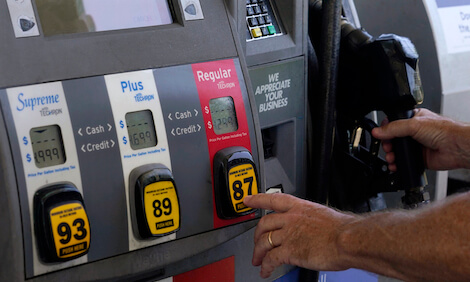


A customer pays $4.29 for a gallon of gasoline.
Sometimes the price of a good or service increases for a specific reason. For example, the price of orange juice might increase if orange crops are poor. Less orange juice available means a higher price.
Inflation is an increase in the prices of all goods and services over time. However, this doesn’t mean prices rise exactly the same for all goods and services. The price of gas may rise by 17 percent in a year, while the price of getting a haircut may rise only 9 percent. The price of a bar of soap may not rise at all.
With so many goods and services available it is tricky to measure inflation. One way the government does this is by using a “basket” of goods and services. This basket represents what a typical American buys each year. The prices of about 94,000 goods and services are tracked in the basket. These can be things like food, doctor’s visits, or rent.
The consumer price index, or CPI, is the overall price change of the basket. The CPI is used to measure inflation. In March 2022, the CPI jumped more than 8 percent from the previous year. This was the greatest increase since 1981. Higher prices for gasoline, food, and rent contributed to the spike. War in Ukraine and the COVID-19 pandemic also contributed.
Most economists believe a small amount of inflation is good for the economy. Salaries and wages usually increase to try and keep up with inflation. But with high inflation, people struggle to afford the things they need. Wages can’t keep up with price increases.
In the United States, the Federal Reserve System, or Fed, acts as the central bank of the nation. The Fed helps control inflation by raising or lowering interest rates. Interest is the amount banks charge people and businesses to borrow money.
In general, raising interest rates helps bring inflation down. Higher rates discourage people and businesses from buying more and prices eventually come down. The Fed tries to keep inflation at 2 percent or less per year.


























